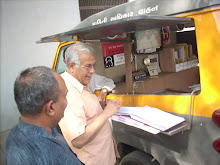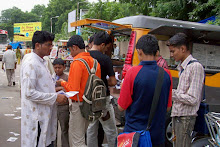Scroll: Delhi: Saturday,
31 August 2024.
Roy exemplifies how personal activism can bring systemic change, making her memoir a vital contribution to understanding and addressing social inequities.
I was first introduced to Aruna Roy was during my undergraduate studies. Our professor began a lecture on the Right to Information Act with her life story, and the entire class was awestruck by this woman who had left the civil services to work at the grassroots level for the real people. After joining the Indian Administrative Service (IAS) in 1968, she soon realised that the civil service, which still retained some of its colonial values, was not the place for her. She resigned in 1975 and joined her husband, Bunker Roy, at the Barefoot College Social Work and Research Centre (SWRC) in Tilonia, Rajasthan.
Given that half of my batch, including myself, was preparing for civil services at that time, the story of Aruna Roy was nothing short of a jolt. We couldn’t fathom what we heard and then read. Some of us despised her choice, while others were bubbling with questions. How much easier it would have been to understand her motivations had we had this memoir to turn to at that time. Now, some of my colleagues who teach various political science courses also introduce the RTI Act with her story, and the students still react with the same awe and more. This is the legacy of Aruna Roy.
The title of Aruna Roy’s memoir, The Personal is Political, reflects the feminist slogan popularised during the second wave of the movement in the 1960s. The phrase encapsulates the central theme of her book: the intersection of personal experiences with broader political issues. In her memoir, Roy explores how women activists encounter gender inequality and patriarchy in various forms. She dives into the deeply ingrained social conditioning of masculinity so refined and internalised that it requires a sensitive and reflective approach to fully understand and address it.
As a woman activist, Roy not only navigated male-dominated spaces but also grappled with the complexities of masculinity itself. Her memoir is a testament to this struggle, written with clarity and evocative power. The narrative is driven by the heartfelt stories of those whose lives have found a space within its pages. Through her memoir, Roy has effectively (re)written history from the margins, giving prominence to voices that are often overlooked. Roy not only acknowledges the voices of ordinary people without which there can be no sustainable change but also makes them the roadmaps to walk on, for her and the younger generations to come.
Perceptions of reality
Upon arriving in Tilonia, Roy, eager to begin her work, asked a local colleague to introduce her to someone she could start a conversation with. He led her to a small courtyard featuring two rooms set at right angles and a hut for a kitchen. A woman emerged from the kitchen, and the colleague left them alone to talk. “The woman was striking…. Suspicion was writ large on her face,” Roy recalls. When the woman inquired about Roy’s purpose, Roy explained that she simply wanted to talk. The woman’s response was blunt: “Get lost! I neither want literacy nor a job. I have my hands full and no time to waste on the likes of you.” This encounter left Roy shaken.
As the memoir progresses, with many recounting of incidents like this one, Roy reflects on how her perceptions of reality were shaped by her privileges as a middle-class urban woman and a former IAS officer. Recognising this, she takes a step back and opens herself to learning from the people she aims to serve. Throughout the memoir, Roy shares stories of women she regards as her teachers, friends, and fellow activists, thus contributing to the oral history tradition in modern times. Her narrative underscores a profound humility and willingness to listen and learn, enriching the discourse on grassroots activism and social change.
Roy challenges the prevalent misconception that women, particularly in rural areas, need skill training to deserve better remuneration. This notion not only undermines the immense labour that these women undertake but also marginalises their work by labelling it as “unskilled”. After all, who determines which activities are considered skilled or unskilled? The sheer number of women engaged in agriculture, construction, domestic support, and animal husbandry demonstrates that “the economy is, in fact, sustained by women,” and their contributions deserve proper recognition.
Ironically, Roy herself experienced the harsh reality of this misconception. She recounts her attempt to work as a daily wage labourer for fifteen days, during which she sustained a permanent back injury. Yet, she regards this as a testament to her argument that such work demands considerable skill. If it were truly “unskilled” labour, she reasons, she would not have encountered any difficulty. Roy contends that these faulty definitions of skill are perpetuated by policymakers who have never engaged in fieldwork themselves. Furthermore, she suggests that this mislabeling is a deliberate strategy to exploit cheap labour without any consequences. The recognition of labour and its political value remain central to Roy’s activism and underscore the broader struggle she has championed throughout her life.
The dual meditation
Roy’s memoir operates as a profound meditation on two distinct yet intertwined levels. On one, she introspectively examines herself – her ideas, choices, rationality, and conscience. This self-reflection is a critical aspect of her journey, revealing her personal growth and the evolution of her understanding. On another level, she questions the broader societal structures she encounters: the patriarchal norms, the theft and disregard for labour, and the hate and violence perpetuated in the name of caste. She also contemplates how to fundamentally overturn these injustices. Her answer? Through empathy and relentless struggle.
On the other, she demonstrates her deep humility and unwavering commitment to social justice. Her reflection on her own privilege. The continuous efforts to learn from the marginalised communities she works with highlight her dedication to elevating those who are often overlooked. Her work serves as a powerful reminder that true activism involves more than advocacy; it requires listening, learning, and championing the voices of those at the margins. By embodying these principles, Roy exemplifies how activism can bridge personal reflection with systemic change, making her memoir a vital contribution to understanding and addressing social inequities.
The Personal is Political: An Activist’s Memoir is not just a recounting of her life and work; it is a manifesto for change. Her memoir stands as both a historical document and a guide for those seeking to understand and challenge the systemic inequalities that persist in our world. Her journey from an IAS officer to a grassroots activist illustrates the transformative power of empathy and commitment. Roy’s insights into gender, labour, friendship, organised resistance and social justice challenge us to rethink our perceptions and engage more deeply with the world around us. Her memoir is a crucial read for anyone interested in understanding the complex interplay of personal experiences and political activism. Roy’s legacy, captured in these pages, will continue to inspire and mobilise future generations towards a more equitable and just society.
Roy exemplifies how personal activism can bring systemic change, making her memoir a vital contribution to understanding and addressing social inequities.
I was first introduced to Aruna Roy was during my undergraduate studies. Our professor began a lecture on the Right to Information Act with her life story, and the entire class was awestruck by this woman who had left the civil services to work at the grassroots level for the real people. After joining the Indian Administrative Service (IAS) in 1968, she soon realised that the civil service, which still retained some of its colonial values, was not the place for her. She resigned in 1975 and joined her husband, Bunker Roy, at the Barefoot College Social Work and Research Centre (SWRC) in Tilonia, Rajasthan.
Given that half of my batch, including myself, was preparing for civil services at that time, the story of Aruna Roy was nothing short of a jolt. We couldn’t fathom what we heard and then read. Some of us despised her choice, while others were bubbling with questions. How much easier it would have been to understand her motivations had we had this memoir to turn to at that time. Now, some of my colleagues who teach various political science courses also introduce the RTI Act with her story, and the students still react with the same awe and more. This is the legacy of Aruna Roy.
The title of Aruna Roy’s memoir, The Personal is Political, reflects the feminist slogan popularised during the second wave of the movement in the 1960s. The phrase encapsulates the central theme of her book: the intersection of personal experiences with broader political issues. In her memoir, Roy explores how women activists encounter gender inequality and patriarchy in various forms. She dives into the deeply ingrained social conditioning of masculinity so refined and internalised that it requires a sensitive and reflective approach to fully understand and address it.
As a woman activist, Roy not only navigated male-dominated spaces but also grappled with the complexities of masculinity itself. Her memoir is a testament to this struggle, written with clarity and evocative power. The narrative is driven by the heartfelt stories of those whose lives have found a space within its pages. Through her memoir, Roy has effectively (re)written history from the margins, giving prominence to voices that are often overlooked. Roy not only acknowledges the voices of ordinary people without which there can be no sustainable change but also makes them the roadmaps to walk on, for her and the younger generations to come.
Perceptions of reality
Upon arriving in Tilonia, Roy, eager to begin her work, asked a local colleague to introduce her to someone she could start a conversation with. He led her to a small courtyard featuring two rooms set at right angles and a hut for a kitchen. A woman emerged from the kitchen, and the colleague left them alone to talk. “The woman was striking…. Suspicion was writ large on her face,” Roy recalls. When the woman inquired about Roy’s purpose, Roy explained that she simply wanted to talk. The woman’s response was blunt: “Get lost! I neither want literacy nor a job. I have my hands full and no time to waste on the likes of you.” This encounter left Roy shaken.
As the memoir progresses, with many recounting of incidents like this one, Roy reflects on how her perceptions of reality were shaped by her privileges as a middle-class urban woman and a former IAS officer. Recognising this, she takes a step back and opens herself to learning from the people she aims to serve. Throughout the memoir, Roy shares stories of women she regards as her teachers, friends, and fellow activists, thus contributing to the oral history tradition in modern times. Her narrative underscores a profound humility and willingness to listen and learn, enriching the discourse on grassroots activism and social change.
Roy challenges the prevalent misconception that women, particularly in rural areas, need skill training to deserve better remuneration. This notion not only undermines the immense labour that these women undertake but also marginalises their work by labelling it as “unskilled”. After all, who determines which activities are considered skilled or unskilled? The sheer number of women engaged in agriculture, construction, domestic support, and animal husbandry demonstrates that “the economy is, in fact, sustained by women,” and their contributions deserve proper recognition.
Ironically, Roy herself experienced the harsh reality of this misconception. She recounts her attempt to work as a daily wage labourer for fifteen days, during which she sustained a permanent back injury. Yet, she regards this as a testament to her argument that such work demands considerable skill. If it were truly “unskilled” labour, she reasons, she would not have encountered any difficulty. Roy contends that these faulty definitions of skill are perpetuated by policymakers who have never engaged in fieldwork themselves. Furthermore, she suggests that this mislabeling is a deliberate strategy to exploit cheap labour without any consequences. The recognition of labour and its political value remain central to Roy’s activism and underscore the broader struggle she has championed throughout her life.
The dual meditation
Roy’s memoir operates as a profound meditation on two distinct yet intertwined levels. On one, she introspectively examines herself – her ideas, choices, rationality, and conscience. This self-reflection is a critical aspect of her journey, revealing her personal growth and the evolution of her understanding. On another level, she questions the broader societal structures she encounters: the patriarchal norms, the theft and disregard for labour, and the hate and violence perpetuated in the name of caste. She also contemplates how to fundamentally overturn these injustices. Her answer? Through empathy and relentless struggle.
On the other, she demonstrates her deep humility and unwavering commitment to social justice. Her reflection on her own privilege. The continuous efforts to learn from the marginalised communities she works with highlight her dedication to elevating those who are often overlooked. Her work serves as a powerful reminder that true activism involves more than advocacy; it requires listening, learning, and championing the voices of those at the margins. By embodying these principles, Roy exemplifies how activism can bridge personal reflection with systemic change, making her memoir a vital contribution to understanding and addressing social inequities.
The Personal is Political: An Activist’s Memoir is not just a recounting of her life and work; it is a manifesto for change. Her memoir stands as both a historical document and a guide for those seeking to understand and challenge the systemic inequalities that persist in our world. Her journey from an IAS officer to a grassroots activist illustrates the transformative power of empathy and commitment. Roy’s insights into gender, labour, friendship, organised resistance and social justice challenge us to rethink our perceptions and engage more deeply with the world around us. Her memoir is a crucial read for anyone interested in understanding the complex interplay of personal experiences and political activism. Roy’s legacy, captured in these pages, will continue to inspire and mobilise future generations towards a more equitable and just society.
















































































